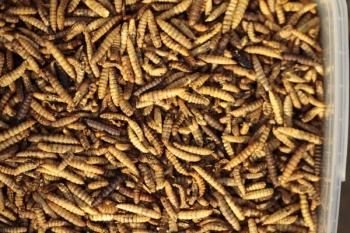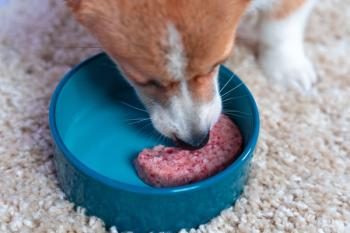
Managing canine obesity: No case is hopeless (Proceedings)
It is the most common nutritional disorder in dogs and cats in the United States.
Obesity
• It is the most common nutritional disorder in dogs and cats in the United States.
· it is estimated that 24% to 44% of dogs and cats in the United States are overweight
Issues or concerns veterinarians face when trying to manage an obese patient
• Failure of veterinarian to acknowledge obesity as a disorder in the patient's record even when noted on physical examination.
• Uncertainty of veterinarian on how to manage obesity
• Fear by the veterinarian of offending client if they tell a client that their pet is overweight.
• Failure of clients to recognize when their pet is overweight
• Failure of clients to perceive risks associated with obesity in their pet
· it is essential that the client buys in to the need for their pet to lose weight
· successful obesity management should be viewed as a partnership between the client and the veterinarian
· it is important for the client to realize some of the risks associated with obesity in their pet
Obese dogs and cats have increased risk of chronic health problems
Conditions caused or complicated by obesity include
• decreased life expectancy
• pulmonary and cardiovascular disease
• exercise and heat intolerance
• joint/musculoskeletal problems and arthritis
• compromised immune function
• pancreatitis
• hyperinsulinemia, glucose intolerance, and diabetes mellitus
• hepatic lipidosis
• increased morbidity and mortality during and following anesthesia (many anesthetics are fat soluble, so it may take longer for recovery)
• decreased fertility/increased dystocia
Route cause of obesity
There is an imbalance between energy intake and energy expenditure energy intake > energy expenditure = energy surplus
Etiologies for imbalance between energy intake and energy expenditure
1. Over-eating
2. Lack of exercise
3. Genetics
a. studies have found genetic components to obesity in some people and rodents
b. the fact that certain breeds of dogs have a disproportionately high incidence of obesity may indicate that genetics is a contributing factors in some dogs and cats
c. breeds associated with high incidences of obesity
4. Endocrine disorders
a. Hypothyroidism
i. dogs should be screened for hypothyroidism prior to initiating an obesity management program
b. Hyperadrenocorticism (Cushings Disease)
ii. obesity occurs in ~50% of dogs with this disease, but an enlarged, pot-bellied abdomen due to liver enlargement and muscle weakness may be erroneously perceived as obesity
5. Gonadectomy
a. obesity is more prevalent in spayed and neutered dogs and cats than in intact ones
i. resting metabolic rate may decrease post spay/neuter
b. keep in mind that just because an animal is spayed or neutered does not mean it has to become overweight
6. Aging
a. as an animal ages, lean body mass (muscle) decreases, resulting in a decrease in metabolic rate
b. aging may also be accompanied by decreasing physical activity
Types of obesity
1. Hypertrophic obesity – increase mass of body fat produced by increased fat cell size but not numbers
a. this is generally the type of obesity that develops in adult onset obesity
2. Hyperplastic obesity – increase mass of body fat produced by both increased fat cell size and number
a. adipocyte hyperplasia occurs during specific critical periods of early growth and occasionally during puberty
i. once fat cells are acquired, they are generally with the animal for life.
b. as a result, hyperplastic obesity is generally more difficult to treat than hypertrophic obesity.
Diagnosing obesity
• Many sophisticated methods, such as duel x-ray absorption (DEXA), are available for diagnosing obesity.
• The most practical ways to diagnose obesity in a clinical setting include:
· body weight
· body condition score (BCS)
Body condition score scales*
Management of obesity
1. Correct or control any underlying diseases (i.e. endocrine diseases)
2. Induce a negative energy balance
a. restrict caloric intake
b. increase energy expenditure (exercise)
c. combination of the two – most successful
3. Calculate caloric restriction [See calculation sheet at end of notes]
Obesity management calculation sheet
4. Divide total daily caloric intake into at least 2 meals rather than one large meal
a. may help with satiety in some animals
b. there is an obligatory cost in energy while digesting and absorbing food called thermogenesis
i. eating multiple smaller meals rather than one large meal induces more thermogenesis, and therefore burns more calories
c. Should you use the patient's "ideal" body weight or "current" body weight? Both methods are acceptable, however, some arguments for using current body weight include:
i. takes the guess work out of determining "ideal" body weight for each patient
ii. a study in dogs revealed the following results (Laflamme D. JAAHA 33:253-259,1997)
· using "ideal" body weight, feeding dogs 50-60% of maintenance energy requirements (MER) resulted in decreased thyroid hormone (T3) levels
· as a result, if estimate of "ideal" body weight is too low, you may already be at levels of caloric restriction that adversely effect T3 levels and metabolic rate
iii. a study in cats revealed similar findings (Center S. J Vet Intern Med 14:598-608, 2000)
· using "ideal" body weight, feeding cats 60% of MER resulted in T4 levels below the normal range in some cats in this study
iv. Therefore, aggressive caloric restriction can negatively affect metabolic rate through down regulation of thyroid hormone production. This is counterproductive in an obesity management program.
d. Another argument for using "current" body weight rather than "ideal" body weight:
i. humans are more likely to experience weight "rebound" following severe caloric restriction rather than moderate caloric restriction
ii. a study in dogs (Laflamme D. Vet Clin Nutr 1:59-65,1994) determined that dogs which lost weight at a rate that did not exceed 1.5% body weight weekly were able to maintain their reduced body weight during 6 months of ad libitum consumption of low-calorie dog food
iii. conclusion: gradual weight loss provides the best chance for long-term success of weight management in dogs
5. Choose an appropriate diet
a. Is it okay to use "maintenance" diets for weight loss?
i. generally not because maintenance diets are formulated to meet the nutritional needs of pets that are a normal weight and consuming a "reasonable" amount of food. The intended use of maintenance diets is not for weight loss, and if they are used for restricting calories, you will also be restricting the intake of other nutrients at the same time.
b. Therapeutic weight loss diets have modified the levels of nutrients such that they contain adequate levels of nutrients while supplying less calories.
i. larger quantities of food can also be fed which may help with satiety
ii. some therapeutic weight loss diets are also supplemented with carnitine. Carnitine helps spare lean body mass during a weight loss program, which is beneficial
c. "Light" diets can be used if the patient does not have a large amount of weight to lose, but it may not work as well in patients with large amount of weight to lose.
d. What about total fasting (starvation) as a weight loss strategy? Never, never, never do this in cats because of high risk for development of hepatic lipidosis
i. also not recommended in dogs either because fasting has both immediate and long-term negative consequences, such as:
· starvation restricts not only calories but also every nutrient, and animals, like people, have daily requirements for nutrients
· excess loss of lean body tissue
· decreased intestinal mass and surface area - increases risk to animal of infections and absorption problems
· studies comparing the outcome of "starvation" weight loss programs vs restricted caloric programs reveal that the net weight loss with starvation is roughly equivalent to that on restricted caloric intake
· increases the likelihood of weight "rebound" when starvation ceases
· starvation is perceived as "inhumane" by most clients (and veterinarians) and the "partnership" between the client and the veterinarian that is needed for successful weight loss could be adversely affected
e. What about treats?
i. the human-animal bond is important to maintain during a weight loss program, and treats play an important role in some of those relationships
ii. if clients that are used to giving treats are told to discontinue treats "cold turkey", they may tell you that they are not giving any treats, but likely may still be giving treats on the side.
iii. it is better to provide the client with a list of options or alternatives that they can use for treats rather than approaching giving treats with a militant view that completely outlaws treats
· one very important goal is to change the habits of the owner that may have contributed to their pets weight gain. Providing the client with a list of options that they can use for treats gets this process started
iv. some options that can be used for low calorie treats include:
· most companies that make therapeutic weight loss diets also make low calorie treats to go with them.
· carrots and celery sticks
· canned green beans (a 14.5 oz can contains only 70 Calories) –even finicky patients may accept green beans
· rice cakes
· unbuttered popcorn
· the pet's own weight loss diet (some animals don't care what they get as long as they get something)
v. It is important to restrict intake of treats to <10% of total daily caloric intake
· most treats are not nutritionally balanced
6. Decide on a rate of weight loss
a. due to lack or "uniform" sizes of dogs and risk of hepatic lipidosis in cats, it is better to recommend a percent loss of body weight per week rather than a standard generic quantity
b. a reasonable goal for rate of weight loss is 1% of body weight/week.
c. weigh animal every 2 weeks
d. How can the owner tell when their pet has reached its "ideal" body weight?
i. the owner should be able to feel the ribs but not see them when pet is standing
ii. pet should have an hour-glass figure when viewed from top
· if pet has thick hair coat, it is important to rely on hands-on assessment of pet, not visual assessment
e. What should you do if an animal's weight loss plateaus during a weight loss program?
i. decrease the quantity of food
ii. recalculate caloric needs based on patient's new "leaner" body weight
iii. increase exercise—this is an important but often overlooked option
· benefits of exercise include: inducing positive changes in body composition (increase muscle while decreasing fat) and raising metabolic rate
Alternative option for weight loss in dogs that do not respond to traditional methods of weight management
Traditional methods of weight loss in dogs
• Induce a negative energy balance using caloric restriction and exercise
• Unfortunately not all dogs respond to traditional approaches of weight loss
• A new, innovative approach for weight loss in dogs is now available
Dirlotapide (Slentrol)
• Dirlotapide (Slentrol, Pfizer Animal Health;
• Slentrol is a selective microsomal triglyceride transfer protein (MTP) inhibitor that blocks the assembly and release of some of the lipoproteins from enterocytes into the bloodstream.
• Microsomal transfer proteins are found in the intestines and in the liver; in vitro studies show that Slentrol selectively inhibits MTP in intestinal cells over hepatic MTP at a ratio 37.5:1.
• Slentrol does not completely block the release of all triglycerides into the bloodstream. Some triglycerides get trapped in enterocytes and end up in the feces when cells are sloughed.
• Slentrol works primarily by decreasing food intake. Acting locally in the small intestine to decrease lipid absorption, dirlotapide increases levels of chemical mediators of satiety such as gut hormone PYY in dogs. The hormone is released from the GI tract and travels in the blood to the level of the hypothalamus where it stimulates satiety.
• Dirlotapide is not a pancreatic enzyme inhibitor and therefore does not interfere with fat digestion in the gastrointestinal tract. Fat is broken down normally in the gastrointestinal tract and undergoes normal absorption into the enterocytes. Thus, the drug does not cause problems associated with pancreatic enzyme inhibitors such as undigested fat passing through the gastrointestinal tract resulting in an oily anal discharge.
• ~ 90% of dirotapide's effect in promoting weight loss is due to a reduction in food intake; the remaining 10% of the effect is due to loss of fat trapped in enterocytes.
• Dirlotapide is administered orally q 24 H.
• The most commonly reported side effects with Slentrol are vomiting, diarrhea and lethargy. Mild to moderate elevations in hepatic transaminases (ALT/AST) that return to normal after the discontinuation of drug therapy have been observed in dogs treated with Slentrol.
• Dirlotapide is contraindicated in cats, as well as in dogs with liver disease or in dogs receiving long-term corticosteroid therapy.
• The safe use of Slentrol has been studied for one year.
• Dirlotapide does not promote weight loss in every dog. Weight rebound is a problem in some patients once therapy is stopped. Successful long-term management of weight loss achieved with Slentrol requires on-going management in the form of caloric restriction and exercise after dirlotapide therapy has been completed.
Newsletter
From exam room tips to practice management insights, get trusted veterinary news delivered straight to your inbox—subscribe to dvm360.






